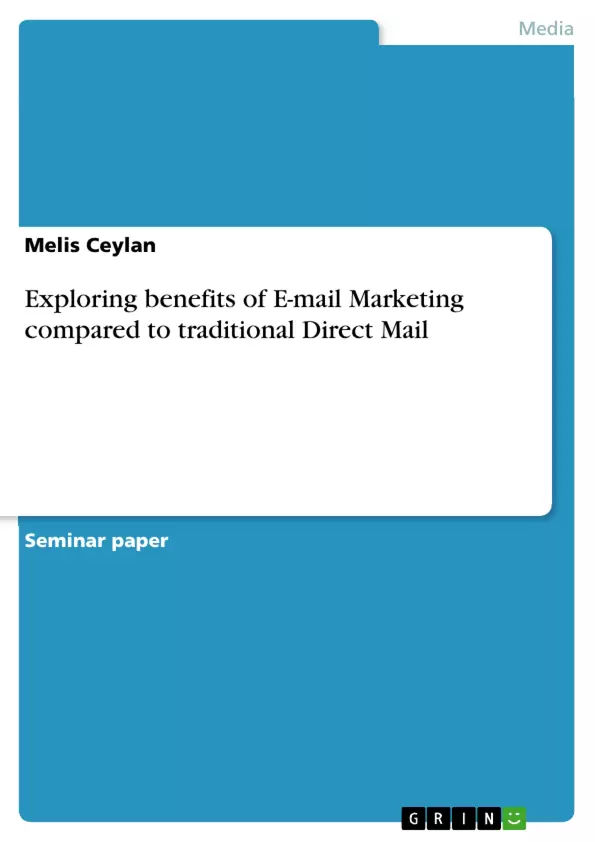Introduction
In the UK, slightly different definitions of direct marketing are made than the ones accepted by the US Direct Marketing Association (DMA). In the UK, it is a method of marketing which develops a direct relationship between the company and its customers in an individual base. Whereas, Stone and Jacobs (2001) define direct marketing as an interactive system of marketing, to effect a response which can be measured, recorded and analyzed on a database for further use.
Roberts and Berger (1989) also affirm that it is an interactive system because both the marketer and the customer communicate with each other. In addition to this, the marketer gives a chance to the individual to respond and gets feedback from the individual. According to Roberts and Berger (1989), the measurability of direct marketing activities is very important. This can be obtained through the opportunity that the particular communication which develops a response from the individual can be identified. Moreover, the contact can be carried through any communications media. As Stone and Jacobs (2001) acknowledge, direct mail is just one of the media which is used for direct marketing among a wide range of other alternatives such as TV, radio, magazines and telephone. With the advent of internet, e-mail has become a new communication channel which is quicker, easier and cheaper. In addition to these, it is mostly interpreted as a media, which can gather more responses and these responses can be measured more easily (Tapp, 2000).
Inhaltsverzeichnis (Table of Contents)
- INTRODUCTION
- DIRECT MARKETING
- DATABASE MARKETING
- DIRECT MAIL
Zielsetzung und Themenschwerpunkte (Objectives and Key Themes)
This text explores the benefits of email marketing in comparison to traditional direct mail. It aims to provide insights into the effectiveness and advantages of each method, particularly in the context of direct marketing and database marketing.
- The evolution and significance of direct marketing
- The role of database marketing in personalization and customer relationship management
- The advantages and disadvantages of traditional direct mail
- The emerging role of email marketing as a direct marketing channel
- The importance of data accuracy and segmentation for both direct mail and email marketing
Zusammenfassung der Kapitel (Chapter Summaries)
- INTRODUCTION: This chapter defines direct marketing and contrasts the UK and US approaches. It highlights the interactive nature of direct marketing and its reliance on data collection for measurement and analysis. The emergence of email marketing as a more efficient and cost-effective channel is discussed.
- DIRECT MARKETING: This chapter explores the benefits of direct marketing, including concentration, immediacy, and personalization. It emphasizes the importance of accurate and up-to-date customer information for effective direct marketing campaigns. The chapter discusses various mediums used for direct marketing, highlighting the potential of email marketing for reaching specific target audiences.
- DATABASE MARKETING: This chapter examines the crucial role of database marketing in achieving successful direct marketing relationships. It outlines the advantages of database marketing, including selectivity, segmentation, and improved customer relationships. The importance of data accuracy and management is stressed to avoid potential issues like duplicate messages and inaccuracies.
- DIRECT MAIL: This chapter focuses on the traditional direct mail approach, emphasizing its reliance on reaching potential customers without prior permission. It highlights the different formats used for direct mail and emphasizes the importance of designing mail pieces that capture attention and encourage action. The chapter concludes with strategies for improving direct mail campaigns, including personalization and emotional appeals.
Schlüsselwörter (Keywords)
This text examines the key concepts of direct marketing, database marketing, and the benefits of email marketing compared to traditional direct mail. It delves into topics such as personalization, customer relationship management, data accuracy, and the importance of targeted campaigns. It highlights the evolution of direct marketing strategies in response to technological advancements and the increasing need for effective communication with specific target audiences.
- Quote paper
- Melis Ceylan (Author), 2007, Exploring benefits of E-mail Marketing compared to traditional Direct Mail, Munich, GRIN Verlag, https://www.grin.com/document/85743



